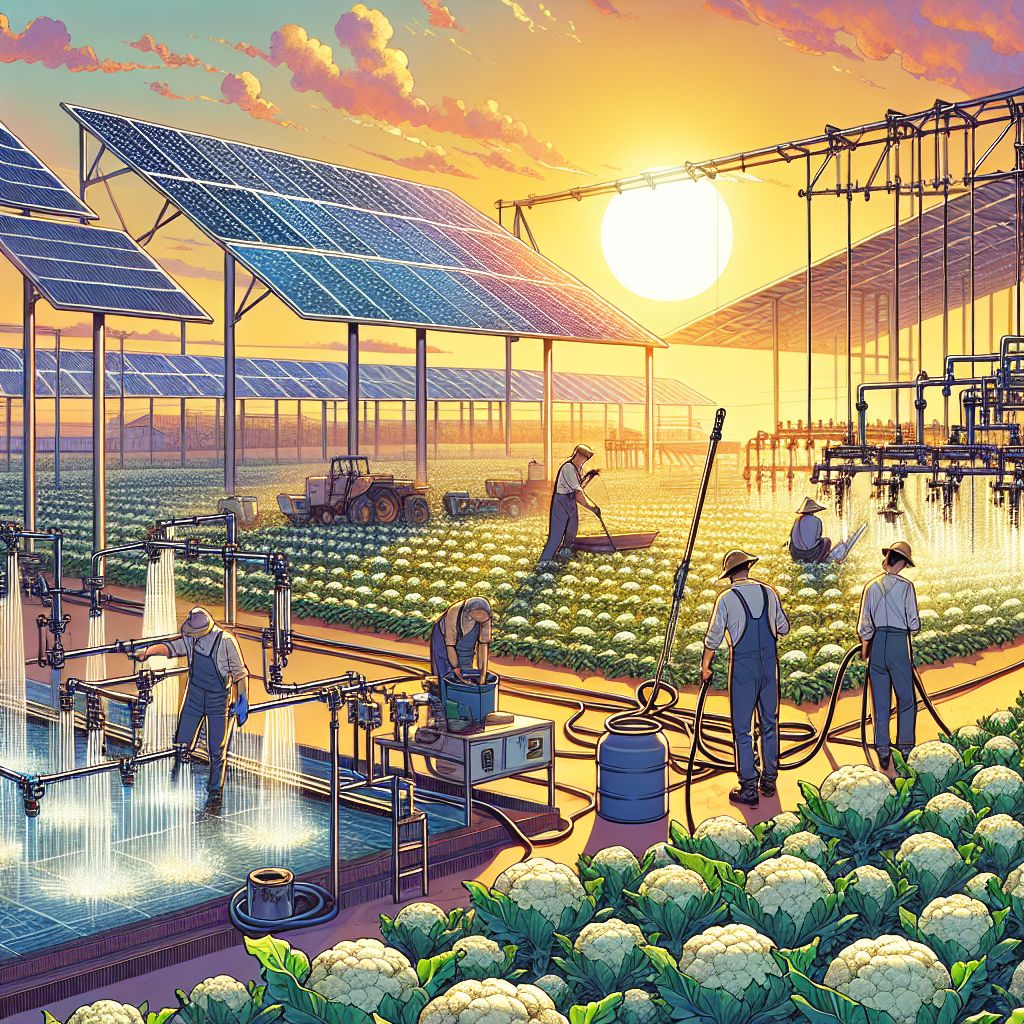
Main Points
Using solar-powered irrigation is a cost-effective and sustainable way to cultivate cauliflower.
Different types of irrigation systems exist, with drip irrigation being the most efficient for cauliflower.
Monocrystalline, polycrystalline, and thin-film are the primary types of solar panels suitable for farms.
Combining solar power with irrigation can result in significant water and energy savings.
The appropriate combination of solar panels and irrigation system depends on the specific needs of your farm.
Benefits of Pairing Solar Panels with an Irrigation System
Let’s discuss how to power your cauliflower farm intelligently. Solar panels and irrigation systems go together like bread and butter—they’re simply better when combined. Utilizing the sun’s energy to power your irrigation system is not only beneficial for the environment, but it’s also financially advantageous in the long run. Moreover, you’ll be embracing the future of farming in a sustainable manner.
The Importance of Sustainable Farming
What’s the point of incorporating solar power into your farming practices? It’s quite simple. As the costs of water and electricity continue to climb, we need to find ways to keep our crops thriving without going bankrupt. Once you have the necessary equipment, solar energy is completely free, and it’s always available—even on overcast days, you’ll still generate some power. The goal is to ensure that we can continue to farm year after year without depleting our resources or causing harm to the land.
The Perfect Union of Solar-Powered Irrigation
Imagine your irrigation system running like a well-oiled machine, powered by the sun. Solar panels convert sunlight into electricity, which then powers your pumps and waters your cauliflower. This perfect union is not just environmentally friendly; it’s efficient. You can time your watering for the coolest part of the day to reduce evaporation, and you don’t have to worry about power cuts stopping your flow.
The great thing about solar-powered irrigation systems is that they can be tailored to suit your needs. Whether you’re growing cauliflower in a small patch or over several acres, there’s a solar solution for you. And the cherry on top? Many systems allow you to control everything from your smartphone or computer. Now that’s convenience!
Enduring Financial and Ecological Advantages
Here’s the skinny: while the initial cost of solar-powered irrigation might seem steep, it’s worth it in the long run. You’ll see savings on your electric bill, and there may even be government incentives available for using renewable energy. On the environmental side, you’ll be decreasing your carbon emissions and saving water—a double victory for you and Mother Earth.
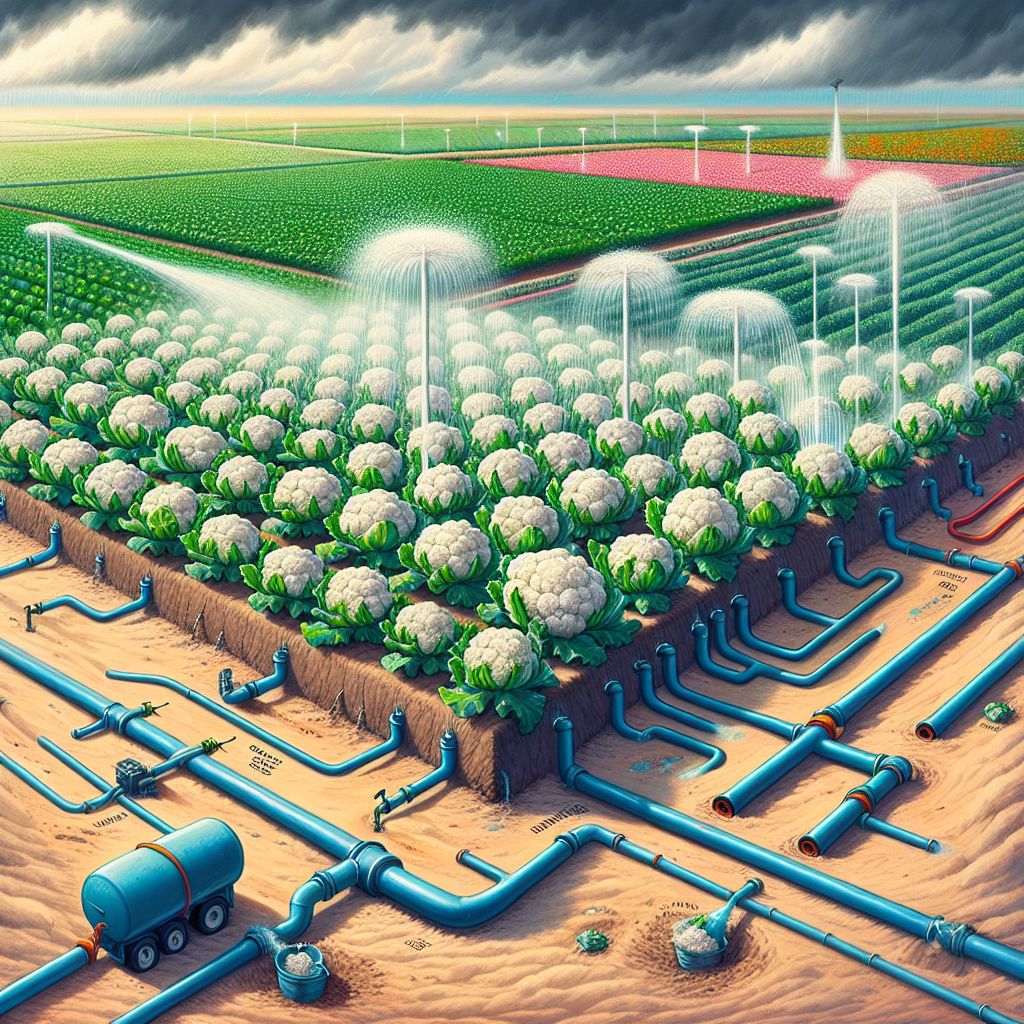
Different Irrigation Methods for Cauliflower Farming
Cauliflower requires a delicate balance of water—not too much and not too little. Therefore, selecting the appropriate irrigation system is crucial. There are several options available, ranging from traditional methods to cutting-edge technology.
Old School Vs. New School Irrigation Methods
Old school irrigation may include drenching your fields or using sprinklers, but these methods can squander a lot of water. New school methods like drip irrigation provide water directly to the base of the plant, which means less waste and less evaporation. That’s crucial when you’re cultivating water-hungry crops like cauliflower.
Understanding Drip, Sprinkler, and Subsurface Irrigation Systems
Drip Irrigation: This method delivers water directly to the roots, reducing wastage.
Sprinkler Systems: These systems can cover large areas but may lead to water evaporation losses.
Subsurface Irrigation: With this system, water is delivered below the surface, which is efficient but can be expensive to install.
When it comes to growing cauliflower, drip irrigation is often the best choice. It’s accurate, it’s efficient, and it keeps the leaves dry, which helps prevent disease. But every farm is unique, so let’s find the system that’s right for your farm.
Take into account your soil type, the size of your farm, and your budget. Drip systems are suitable for all types of soil, but they’re particularly effective for sandy soil that drains rapidly. If you’re working with a smaller budget, you might want to start with a basic drip system and then expand it as time goes on.
Choosing the Best Irrigation System for Your Cauliflower Garden
When choosing the best irrigation system, consider your daily schedule. How much time can you dedicate to upkeep? Drip systems require regular inspections for blockages, but they’re generally easy to maintain. Sprinklers may require more care to ensure they’re watering all your plants uniformly.
Also, take into account your local weather. If you reside in a region with a lot of wind, sprinklers may not be the best option because a lot of water will be lost to evaporation and drift. In such a scenario, drip or subsurface irrigation may be more suitable choices.

Different Solar Panels You Can Add to the Irrigation System to Grow Cauliflower on a Farm
Integrating solar panels into your cauliflower irrigation system is a wise investment that enhances efficiency, reduces costs, and aligns with environmental conservation goals. By understanding the different solar panel options and selecting the right one, you can empower your cauliflower cultivation with reliable and sustainable irrigation. Embrace renewable energy and reap the benefits of thriving crops and a greener future. Lets take a look at the different types of solar panels you can integrate into your irrigation system:
Monocrystalline Panels: The Efficient Choice for Cauliflower Cultivation
Monocrystalline solar panels are the preferred choice for efficiency. They are composed of a single, pure crystal structure that allows them to convert more sunlight into electricity compared to other types. This means you need less panels to generate the same amount of power – ideal for irrigating your cauliflower crops without occupying too much space.
Polycrystalline Panels: Budget-Friendly Irrigation Solutions
Polycrystalline panels offer a more affordable option. They’re created by fusing several silicon crystals together, a process that is cheaper than that used to produce monocrystalline panels. Although they’re not as efficient, they’re still very effective, and the money you save on initial costs can be used to improve other aspects of your farm.
Thin-Film Solar Panels: Flexible Installation Options
Thin-film solar panels are the latest addition to the solar panel family. Their lightweight and flexible nature allows them to be installed on a variety of surfaces that may not be able to hold up heavier panels. This makes them an excellent option for farm buildings that have less structural support.
They can be laid out like a carpet on a flat surface.
They’re less influenced by high temperatures, which is ideal for hot climates.
They have a lower efficiency rate, but their flexibility can make up for it in the right situation.
Remember that while thin-film panels offer a lot of adaptability, they generally require more space due to their lower efficiency. They’re also less robust than their crystalline counterparts, so they might not be the best option if your farm experiences harsh weather conditions.
Right below is a table looking at all the different solar panel options:
|
Solar Panel Type |
Efficiency Range |
Advantages |
Disadvantages |
|---|---|---|---|
|
Monocrystalline |
17-22% |
Highest efficiency, space-saving, long lifespan. 2 | |
|
Polycrystalline |
15-17% |
Lower efficiency, requires more space. 2 | |
|
Thin-Film |
10-13% |
Lightweight, flexible, good temperature coefficient. 2 |
Lowest efficiency, requires large area. 2 |
Monocrystalline panels provide the highest efficiency in a compact area but at a higher upfront cost (2, 3). Polycrystalline panels offer a balance of efficiency and cost (2, 3). Thin-film panels have lower efficiency but perform better in high temperatures (2). The optimal choice depends on factors like available space, budget, local climate conditions, and specific irrigation requirements for the cauliflower.
What Solar Panel Should I Use for Cauliflower Cultivation
If you’re planning on growing cauliflower, you’ll need a solar panel that can do the job without being overkill. Monocrystalline panels are usually the way to go because of their efficiency, especially if you’re short on space. However, if you’re a beginner or have a bigger area to cover, polycrystalline or thin-film panels can still give you the power you need to run your irrigation system effectively.
Connecting Solar Panels to Your Irrigation System
Now, let’s discuss how to connect solar panels to your irrigation system. It’s similar to setting up a new smartphone—it may take some time to get everything coordinated, but once it’s operational, it’s a breeze. You should consult with a professional to ensure your solar panels are correctly connected to your pumps and that everything is set up for optimal efficiency.
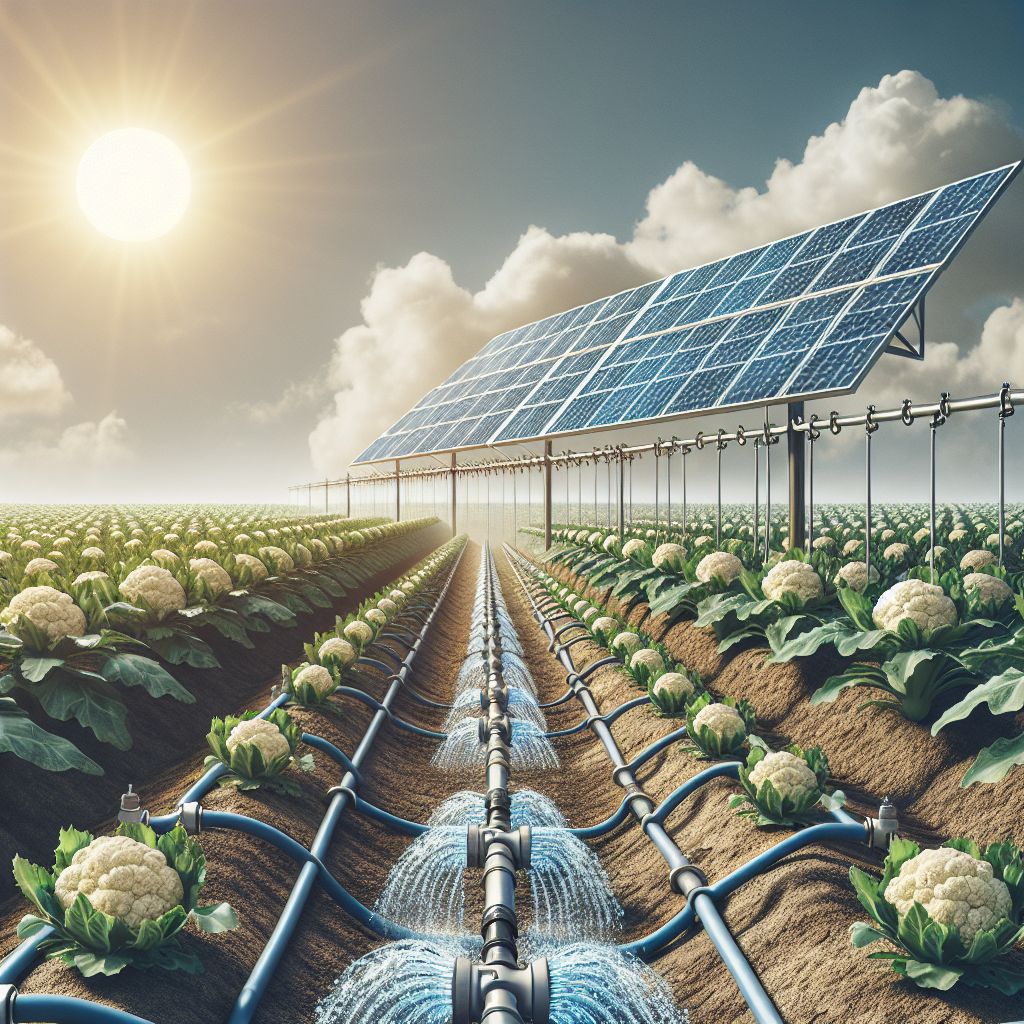
Why Solar Irrigation Systems are More Cost-Effective and Efficient for Growing Cauliflower than Traditional Irrigation Systems
While it may seem like a big financial commitment to switch to solar irrigation, the benefits make it worth it. You will be less dependent on the grid and won’t have to worry about fluctuating energy costs. You will also be contributing to a more sustainable farming system. And don’t forget the potential water bill savings, as systems like drip irrigation are more efficient.
This table compare the pros and cons of solar-powered irrigation systems and conventional irrigation systems:
|
Aspect |
Conventional Irrigation System |
Solar-Powered Irrigation System |
|---|---|---|
|
Pros |
No ongoing energy costs, uses free solar power. 5 | |
|
Simple installation and maintenance. 1 |
Environmentally friendly, reduces carbon footprint. 3 | |
|
Reliable water supply even during power outages. 5 | ||
|
Long lifespan of solar panels (25-30 years). 5 | ||
|
Cons | ||
|
Susceptible to power outages. 5 |
Requires some technical knowledge for installation/maintenance. 3, 4 | |
|
Environmental impact from energy use. 3 |
Risk of over-abstraction of groundwater if not managed properly. 3, 4 | |
|
Potential for water waste/inefficiency. 1 |
Analysis of Initial Investment and Payback Period
While the initial cost may be substantial, consider it as sowing a seed that will eventually grow into a tree of money. The system will pay for itself over time thanks to the savings you’ll make on energy and water. The speed at which this happens is determined by a few factors, including the efficiency of the drip irrigation system you choose for your cauliflower crops on loams.
The size of your solar installation
• Your current expenses on electricity and water
• Any incentives or rebates you can take advantage of
Typically, you can expect to recoup your investment in a few years. After that, it’s pure profit!
Evaluating the Water and Energy Conservation of Solar-Powered Systems
When you use solar panels to power your irrigation, you’re making use of a renewable resource. This not only saves you money, but also helps conserve water. For example, drip irrigation systems can conserve up to 50% more water compared to conventional methods. Plus, since you’re using energy from the sun, you’re not consuming fossil fuels to irrigate your crops.
Case Studies: Practical Efficiency
There are farmers currently enjoying the advantages of solar-powered irrigation. For instance, John installed solar panels to power the drip irrigation system for his cauliflower crops, and he has reduced his water usage by 40%. His energy bills? They’ve decreased by 60%. And with the high quality of his produce, he’s getting better prices at market. That’s what we call a triple win.
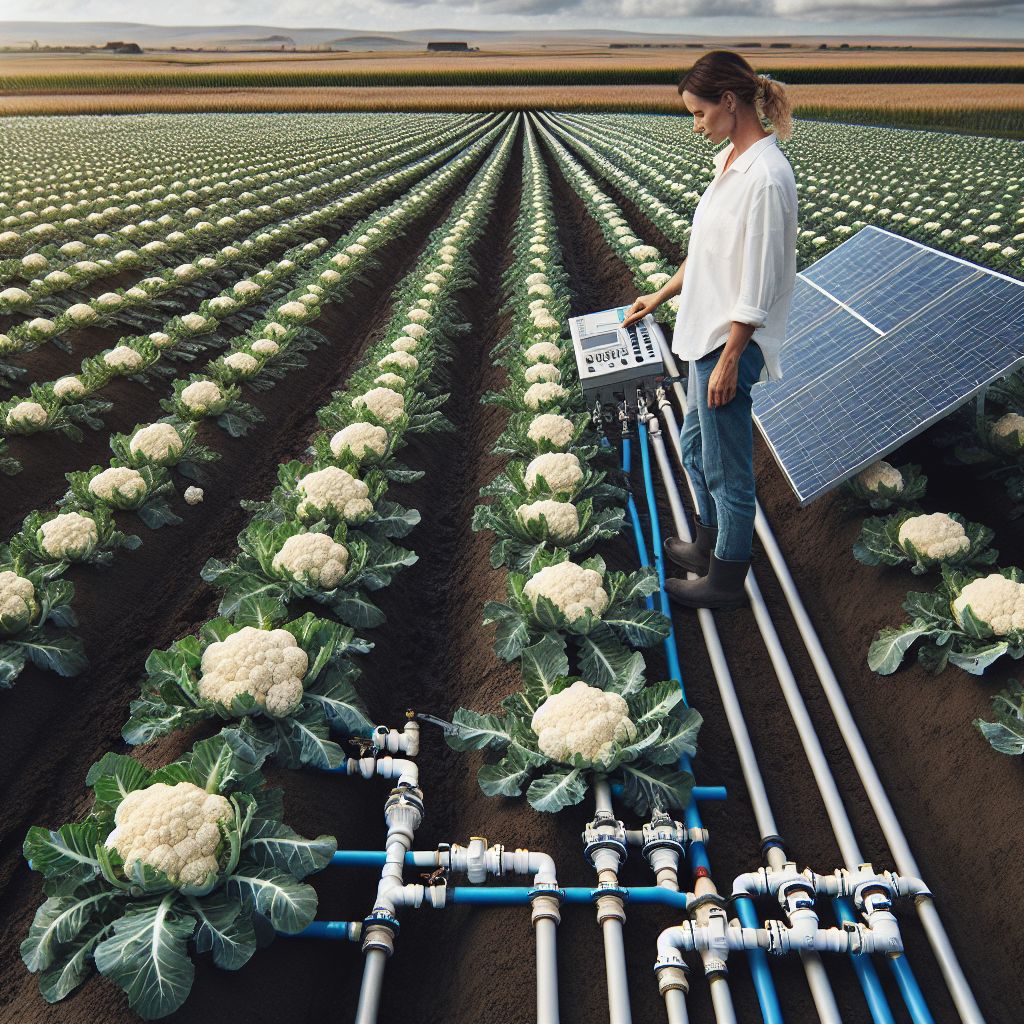
How to Choose the Right Solar Panels and Irrigation System for Your Cauliflower Farm
The best solar panels and irrigation system for your cauliflower farm will depend on your specific circumstances. You’ll need to consider factors like your climate, soil type, and the size of your farm. However, many cauliflower farmers have found that monocrystalline panels combined with drip irrigation offers the best balance of efficiency and cost-effectiveness.
Assessing the Efficiency of Integrated Systems
Monitoring your system’s performance is crucial. Is your cauliflower crop receiving sufficient water? Are your panels generating the predicted amount of power? Regular checks and maintenance can help you identify any problems early and ensure your system operates efficiently.
Keep in mind that as your farm develops, the most suitable system for you may evolve. What’s effective for a small-scale farm may not be the best choice when you start to expand. Always be prepared to adjust and adapt as your requirements shift.
At this point, you should have a clear understanding of the advantages of using solar-powered irrigation and how to select the best system for your cauliflower farm. Now, go out there and grow in a sustainable way!
Regularly check your crops and adjust your watering schedule as needed.
Regularly clean your solar panels and monitor them to ensure they are working at their best.
Keep up to date with the latest technology and upgrades that could benefit your farm.
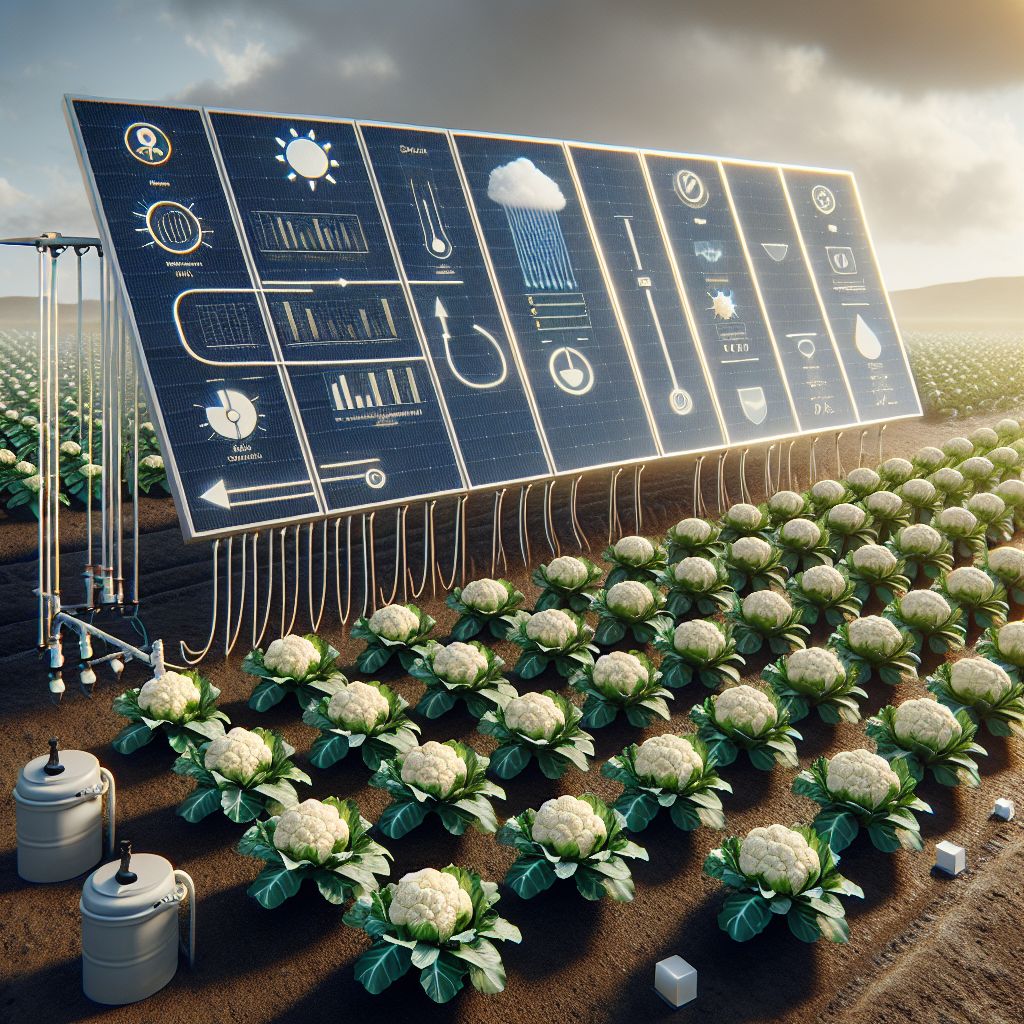
What is the Best Solar Panel and Irrigation System Combination for a Cauliflower Farmer
If you’re a cauliflower farmer considering making the switch to solar-powered irrigation, the best combination for you will depend on several factors. These include your budget, the size of your farm, and your specific agricultural needs. However, one combination that stands out for its balance of efficiency and cost is monocrystalline solar panels and drip irrigation systems. This combination is known for its high energy efficiency and precise water delivery. This makes it perfect for the precise water needs of cauliflower.
Assessing the Efficiency of Integrated Systems
It is vital to regularly assess the performance of your integrated solar and irrigation system to ensure you are maximizing your investment. Keep an eye on the output of your solar panels and your water consumption. Are your utility bills decreasing? Is your cauliflower crop flourishing? As you become more familiar with your new system, you may need to make some adjustments, but the advantages of this sustainable method will become more and more apparent.
Remember, the effectiveness of solar panels can be influenced by factors like location, tilt, and cleanliness. Ensure they are set up in a spot that gets the most sun and clean them frequently to stop dust and debris from lowering their efficiency.
Professional Suggestions for System Combinations
Professional suggestions are unanimous: begin with a thorough assessment of your farm’s unique circumstances. This involves studying sunlight trends, soil composition, and water requirements. Professionals frequently recommend monocrystalline solar panels for their long-term dependability and effectiveness, particularly when combined with low-pressure drip irrigation systems that decrease water and energy waste.
Moreover, incorporating intelligent technology into your setup can enhance water utilization and energy usage. Intelligent sensors and timers can modify watering schedules according to weather predictions, soil moisture content, and plant growth phases, guaranteeing that your cauliflower gets the perfect quantity of water at the correct time.
Conclusion:
So, in conclusion, it’s evident that solar-powered irrigation is an intelligent, eco-friendly option for those growing cauliflower. By thoughtfully choosing the best combination of solar panels and irrigation systems, you can boost your farm’s productivity, save on running costs, and do your bit for the environment. Adopt this forward-thinking method and see your farm thrive in this era of sustainability.
Investing in the Future of Eco-Friendly Cauliflower Cultivation
With solar-powered irrigation systems, cauliflower cultivation has a promising and eco-friendly future. By adopting this technology, you’re not only securing your farm’s future but also contributing to the well-being of our planet. Sustainable farming techniques such as solar irrigation are crucial for meeting the agricultural needs of an increasing population while conserving valuable natural resources.
Why Solar-Powered Irrigation Makes Sense for Eco-Friendly Farmers
If you’re a farmer who cares about the environment, there’s really only one choice when it comes to irrigation: solar power. Not only will you save money in the long run, but you’ll also be doing your part to protect the planet. So why not make the smart choice for your cauliflower crops and for future generations by investing in solar-powered irrigation?
Frequently Asked Questions
Why is Solar-Powered Irrigation Considered Sustainable?
The sustainability of solar-powered irrigation comes from its use of a renewable energy source, the sun, to power the water delivery systems. This lessens the dependence on non-renewable energy sources and decreases the carbon footprint of farming practices. Moreover, when paired with water-efficient irrigation methods such as drip systems, it saves water and minimizes waste.
How Much Space Do Solar Panels Require on a Cauliflower Farm?
The space required for solar panels will vary based on the size of your irrigation system and the energy needs of your farm. A professional evaluation can identify the most effective arrangement. Typically, a small panel array can supply power to a small drip irrigation system, with the size increasing for bigger operations.
Keep in mind that solar panels can be placed on rooftops or unused areas, making them flexible for different farm designs.
When you are setting up your solar panels, make sure you leave room for potential future growth.
Is it Possible to Automate Solar-Powered Irrigation Systems?
Yes, it is! Solar-powered irrigation systems can be fully automated using timers, sensors, and controllers. This technology enables the exact scheduling of irrigation events, which can be adjusted based on real-time data such as soil moisture levels and weather forecasts.
Not only does automation save time, but it also improves the efficiency of water and energy use, making your farm more sustainable overall.
Does the Government Offer Incentives for Solar Irrigation?
In many areas, the government offers incentives for using renewable energy technologies, such as solar irrigation systems. These incentives may include tax credits, rebates, or grants. To find out what programs are available in your area, check with your local and national government agencies.
How Does the Weather Influence Solar-Powered Irrigation?
The performance of solar-powered irrigation systems can be affected by weather patterns. However, today’s solar panels are engineered to absorb sunlight even when it’s cloudy, although their output might be diminished. Moreover, intelligent irrigation systems can modify watering in response to weather conditions, guaranteeing that your crops get the appropriate amount of water regardless of the weather forecast.
Taking into consideration the changing weather patterns when planning your irrigation can help you get the most out of your solar-powered system all year round.







Leave a Reply